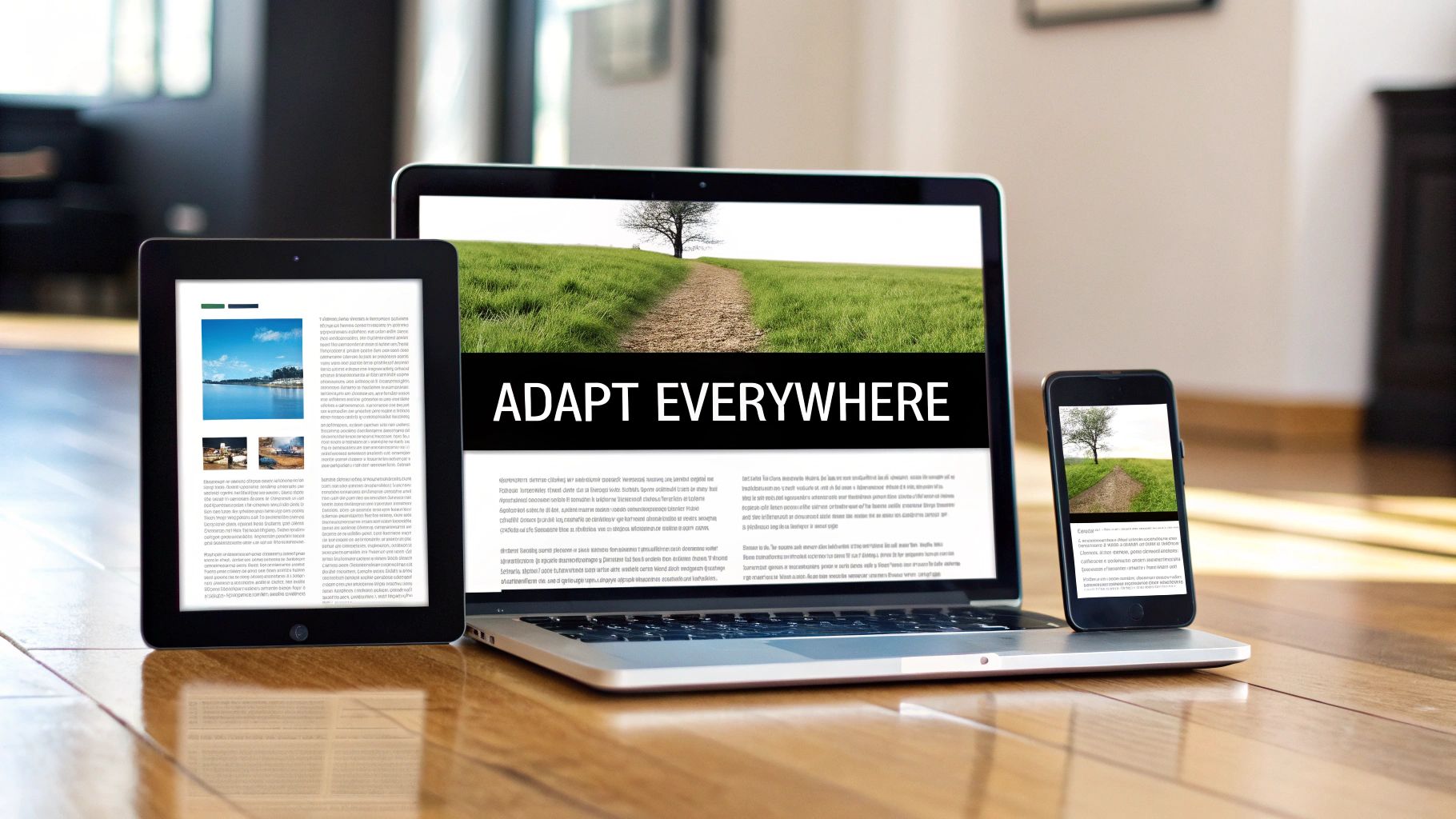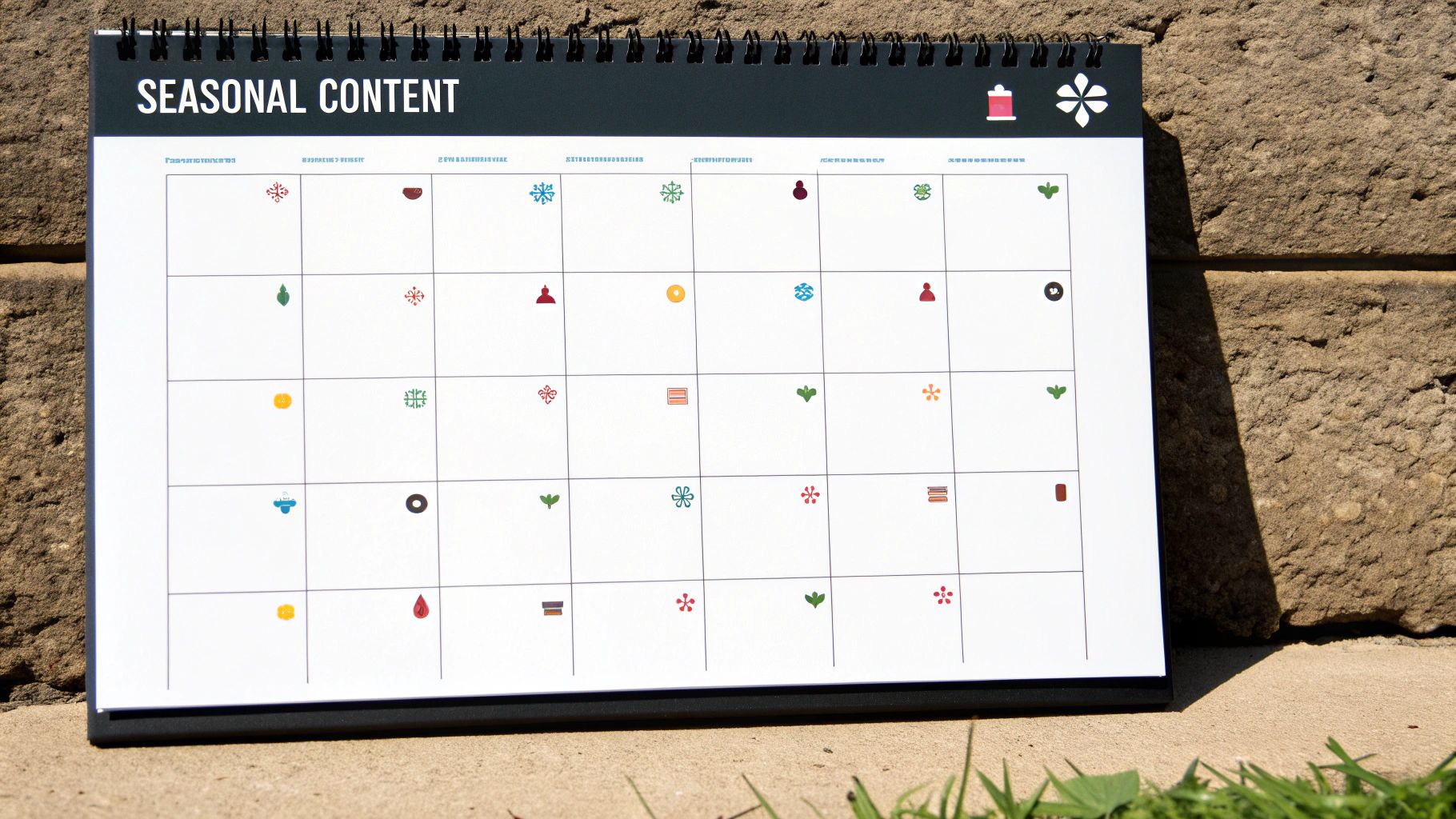In the fast-paced digital marketplace, a simple spreadsheet filled with post ideas no longer cuts it. A truly effective content calendar is a strategic command center, a dynamic roadmap that guides your brand's narrative across all channels. Moving beyond basic scheduling to adopt advanced content calendar best practices is the difference between simply posting content and building a connected, engaged audience. This is where the real work of creating an effective content plan begins, transforming a static document into a powerful engine for growth.
This guide moves past the obvious and unveils eight proven, actionable strategies to revolutionize your planning. We will explore how to build a resilient, data-informed, and highly efficient system that aligns every piece of content with your core business objectives. With a special focus on maximizing your evergreen content's lifespan using tools like EvergreenFeed, you'll learn to structure a flexible yet powerful workflow. Prepare to refine your planning process, ensuring your content delivers consistent, high-impact results that resonate with your audience and drive measurable success.
1. Strategic Content Pillar Development
Instead of brainstorming random content ideas, one of the most effective content calendar best practices is to build your entire strategy around a few core themes. Strategic content pillars are the 3-5 foundational topics that your brand will consistently own. These pillars directly connect your business goals, your audience’s needs, and your brand's unique expertise, ensuring every piece of content you create has a clear purpose.

Think of these pillars as the main categories in your brand’s magazine. For example, a brand like Nike doesn’t just post about shoes; its pillars are broader concepts like Performance, Inspiration, and Innovation. This framework allows them to create a wide variety of content, from athlete stories to tech breakdowns, that all reinforce their core brand message. Similarly, Whole Foods centers its content on pillars like Recipes, Health & Wellness, and Sustainability.
Why This Approach Works
This method transforms your content from a scattered collection of posts into a cohesive and strategic asset. It simplifies content creation by providing a clear framework, preventing you from ever asking, "What should we post today?" A pillar-based strategy ensures your social media feeds, especially those managed with evergreen scheduling tools, offer diverse yet consistent value. This keeps your audience engaged and reinforces your brand authority in specific key areas.
How to Implement Content Pillars
Follow these steps to establish a strong pillar foundation for your content calendar:
- Audit Your Best Content: Review your past posts. Identify the topics and formats that generated the most engagement, shares, and conversions. These high-performers often reveal your natural content pillars.
- Define 3-5 Core Themes: Based on your audit, brand mission, and audience research, select your pillars. A fitness app might choose pillars like Workout Tips, Nutrition, and Mindset, while a B2B software company might focus on Productivity Hacks, Industry Trends, and Customer Success Stories.
- Develop Sub-Topics: Break down each pillar into smaller, more specific sub-topics. For a "Nutrition" pillar, sub-topics could include Meal Prep Ideas, Healthy Snacking, and Understanding Macros. This adds variety and depth, making it easy to generate months' worth of content ideas for your calendar.
2. Cross-Platform Content Adaptation Strategy
Instead of creating unique content for every platform from scratch, a more efficient content calendar best practice is to develop a single, high-value piece of content and strategically adapt it for different channels. This cross-platform adaptation strategy involves tailoring your core message to fit the unique format, audience expectations, and algorithmic preferences of each social network. It maximizes your content's ROI while ensuring every post feels native and authentic to its platform.

This approach, famously championed by entrepreneurs like Gary Vaynerchuk, transforms one central idea into dozens of assets. For instance, a detailed blog post can be deconstructed into a concise LinkedIn article, a visually engaging Instagram carousel, a quick-tip TikTok video, and a multi-tweet thread. Similarly, a brand like Morning Brew effectively atomizes its newsletter insights into shareable Instagram stories and professional LinkedIn updates, reaching different audience segments where they are most active.
Why This Approach Works
This strategy allows you to "work smarter, not harder," amplifying your message without exponentially increasing your workload. By adapting one idea, you maintain a consistent brand voice across all channels while respecting the nuances of each platform. This method ensures your content calendar is always full of high-quality, relevant material that is optimized for performance, from detailed professional insights on LinkedIn to quick, entertaining clips on TikTok.
How to Implement Cross-Platform Adaptation
Follow these steps to integrate a content adaptation strategy into your workflow:
- Start with a Core Asset: Begin with a substantial piece of content like a blog post, podcast episode, or webinar. This will serve as the "source material" for all adaptations.
- Create an Adaptation Matrix: Map out how your core asset can be transformed for each platform. For a blog post, this might look like: Twitter (Key Quotes/Stats), Instagram (Carousel with Main Points), LinkedIn (Professional Summary), and YouTube (Short Explainer Video).
- Tailor for Each Platform: Don't just copy and paste. Rewrite captions, adjust visuals, and change the tone to match the platform. A professional tone works for LinkedIn, while a more casual, trend-focused approach is better for TikTok.
- Track Performance Individually: Monitor how each adapted piece performs on its respective platform. This data will reveal which formats resonate most with each audience, helping you refine your strategy over time.
By mastering this method, you can significantly increase content output and engagement. For a deeper dive into this topic, explore these powerful content repurposing strategies.
3. Data-Driven Content Planning and Optimization
Moving beyond intuition and guesswork is a cornerstone of modern marketing. One of the most impactful content calendar best practices is to let data guide your decisions. This approach involves systematically using analytics, audience insights, and performance metrics to inform what you create, when you post, and how you refine your strategy over time, ensuring every decision is based on evidence rather than assumptions.

This methodology is powerfully demonstrated by major brands. Spotify analyzes listening data to create its hyper-personalized "Wrapped" campaigns, which become massive viral events. Similarly, Netflix uses viewing data to create targeted social media content that resonates with specific audience segments, promoting shows with different angles depending on viewer preferences. This ensures maximum relevance and engagement.
Why This Approach Works
A data-driven strategy transforms your content calendar from a static plan into a dynamic, responsive tool for growth. It helps you identify high-performing content types, optimal posting times, and topics that truly resonate with your audience. This not only boosts engagement but also maximizes your return on investment by focusing resources on what is proven to work. To ensure your content not only engages but also converts, exploring effective Ecommerce conversion rate optimization tips can provide valuable insights for your data-driven planning.
How to Implement Data-Driven Planning
Incorporate data into your workflow with these actionable steps:
- Establish Key Metrics: Use platform-native insights and tools like Google Analytics to track metrics such as engagement rate, reach, click-through rates, and conversions. Establish a baseline so you can accurately measure the impact of your efforts.
- Conduct Regular Audits: Schedule monthly or quarterly review sessions to analyze your content performance. Identify patterns in your top-performing posts. Are they videos, carousels, or text-based? What topics generate the most discussion? Use these insights to inform your next content cycle.
- Optimize and Iterate: Use your findings to make specific adjustments. Test different posting times, experiment with successful formats, and double down on topics your audience loves. A deeper understanding of content performance analysis can further refine this process. Learn more about how to effectively measure your social media ROI to optimize your strategy.
4. Seasonal and Event-Based Content Integration
While content pillars provide a stable foundation, another of the most powerful content calendar best practices is to strategically incorporate seasonal trends, holidays, industry events, and cultural moments. This approach layers timely relevance on top of your evergreen strategy, capturing audience attention when it's at its peak and showing that your brand is current and connected.

Think of Starbucks' annual Pumpkin Spice Latte launch, which has become a cultural event in itself, creating massive organic buzz each fall. On a more spontaneous level, Oreo's legendary "You can still dunk in the dark" tweet during the 2013 Super Bowl blackout demonstrated the immense power of real-time event marketing. This blend of planned seasonal campaigns and agile, reactive content can generate significant engagement and brand affinity.
Why This Approach Works
Integrating event-based content makes your brand part of a larger conversation your audience is already having. It taps into existing excitement and search trends, boosting visibility and engagement. For holidays and recurring seasons, you can create evergreen seasonal content that gets reused and updated annually, making it a highly efficient part of your content calendar. This tactic ensures your brand feels dynamic and relevant, preventing your feed from becoming monotonous.
How to Implement Seasonal and Event-Based Content
Follow these steps to effectively integrate timely events into your content calendar:
- Create an Annual Events Calendar: At the start of the year, map out all major holidays, awareness days, industry conferences, and seasonal periods relevant to your audience. This forms your proactive planning framework.
- Prepare Evergreen Seasonal Assets: For recurring events like Christmas or Summer, develop a library of content (graphics, blog posts, video templates) that can be easily refreshed and reused each year. This is a perfect use case for scheduling tools that handle evergreen content.
- Establish a Rapid-Response Process: For unexpected cultural moments, have a clear and agile workflow in place. This includes social listening to spot opportunities, a quick-turnaround creative process, and a streamlined approval chain to ensure you can react while the topic is still trending.
5. Content Batching and Production Workflow Optimization
Instead of creating content one piece at a time, a more powerful strategy is to organize your production into focused sessions. One of the most effective content calendar best practices is content batching, where you group similar creative tasks and complete them in a single, dedicated block of time. This systematic approach minimizes the mental cost of context switching and transforms your content creation from a chaotic scramble into a streamlined, predictable process.
Think of it like an assembly line for your content. Instead of designing one graphic, writing one caption, and then scheduling one post, you dedicate specific days or hours to a single activity. For example, a brand like Buffer is known for batching tasks, such as dedicating Mondays to creating all social media graphics for the week and Wednesdays to writing blog posts. This method maximizes focus and ensures a consistent level of quality across all assets.
Why This Approach Works
Content batching significantly boosts productivity by allowing you to enter a state of deep work. By focusing on one type of task, such as writing all your email newsletters or editing all your short-form videos, you reduce setup time and maintain creative momentum. This workflow optimization is essential for preventing burnout and ensuring your content calendar remains consistently populated with high-quality material, even during busy periods.
How to Implement Content Batching
Follow these steps to build an efficient batching system for your content calendar:
- Group Similar Tasks: Audit your entire content creation process and group tasks by type. Common batches include Writing (captions, blog posts, scripts), Design (graphics, thumbnails), Filming (all video content for the month), and Scheduling (loading everything into your evergreen scheduling tool).
- Create Templates and Checklists: Standardize your workflow for each content type. Develop templates for social media graphics, video scripts, or blog post outlines. A simple checklist for each task ensures no steps are missed and maintains quality control.
- Schedule and Protect Batching Time: Block out specific, non-negotiable time on your calendar for each batch. Treat these sessions like important meetings. For example, dedicate the first Tuesday of every month to filming all your YouTube videos or every Friday morning to writing and scheduling social posts.
6. Audience-Centric Content Mapping
Beyond simply knowing what you'll post, one of the most crucial content calendar best practices is mapping every piece of content directly to a specific audience need. Audience-centric content mapping involves aligning your calendar with detailed customer personas and their journey. This ensures that each post, article, or video serves a clear purpose for a specific segment of your audience at a particular stage of their relationship with your brand.
This strategic approach moves your content from broadcasting a single message to having a targeted conversation. For example, HubSpot doesn't just create content for "marketers"; it develops distinct content tracks for marketing managers, sales representatives, and customer service professionals, each with unique pain points. Similarly, Mailchimp tailors its resources for small business owners at different growth stages, from starting out to scaling up.
Why This Approach Works
Mapping content to audience needs and journey stages makes your marketing efforts significantly more effective and efficient. It ensures you create content that resonates deeply, answers specific questions, and gently guides users toward a solution, your product or service. This personalization builds trust and authority, transforming passive followers into loyal customers. It prevents you from wasting resources on content that, while well-produced, speaks to no one in particular.
How to Implement Audience-Centric Mapping
Follow these steps to integrate audience mapping into your content calendar process:
- Develop Detailed Personas: Go beyond basic demographics. Create detailed personas that include goals, challenges, pain points, and preferred content formats. What questions are they asking at each stage of their journey?
- Map the Customer Journey: Define the key stages your audience moves through: Awareness (problem identification), Consideration (solution evaluation), and Decision (purchase). What information do they need at each stage?
- Create a Content Matrix: Build a simple grid with your personas on one axis and the customer journey stages on the other. Use this matrix to brainstorm targeted content ideas that fill each box, ensuring you have valuable touchpoints for every key segment.
- Tag and Track Content: Use tags within your content calendar and analytics tools to categorize content by persona and journey stage. This allows you to measure what's resonating with specific audience segments and optimize your strategy accordingly.
7. Flexible Content Calendar Architecture
While detailed planning is crucial, one of the most advanced content calendar best practices is building in adaptability. A flexible content calendar architecture is a strategic framework that balances meticulously planned content with the agility to capitalize on unexpected opportunities. This approach ensures your brand can remain relevant and responsive without derailing your long-term content strategy.
This means your calendar isn't a rigid, unchangeable document. Instead, it’s a living blueprint with designated “flex slots” for real-time marketing, trending topics, and experimental content. For instance, the social media team at Wendy's famously reserves capacity for their witty, real-time responses to cultural moments and competitors. Likewise, Netflix constantly adapts its content schedule to align with surprise hit shows and evolving online conversations, proving that agility and planning can coexist.
Why This Approach Works
A rigid calendar can make your brand appear out of touch when major news breaks or a viral trend takes over. A flexible architecture allows you to join timely conversations, demonstrating relevance and personality. This proactive agility keeps your brand dynamic and engaging, preventing your feed from becoming a predictable stream of pre-scheduled posts. It also empowers your team to experiment and innovate, discovering new content formats that resonate with your audience.
How to Implement a Flexible Architecture
Follow these steps to build agility directly into your content planning process:
- Apply the 70-20-10 Rule: Structure your calendar so that 70% of content is planned, strategic material (like pillar content), 20% is dedicated to content that adapts or riffs on trending topics in your industry, and 10% is reserved for completely new, experimental formats or ideas.
- Create 'Flex Slots': When you build your weekly or monthly calendar, intentionally leave a few slots empty. Mark these as “Flexible” or “Topical.” This visually reminds your team to look for timely opportunities instead of scrambling to make room.
- Develop Rapid-Response Protocols: Establish a clear and simple process for creating and approving content quickly. This might include pre-approved templates or a streamlined chain of command for time-sensitive posts, ensuring you can act before a trend becomes old news. You can learn more about creating a marketing calendar that accommodates this agility.
8. Cross-Functional Content Calendar Collaboration
Your content calendar shouldn't operate in a silo. A truly effective plan integrates insights and needs from across your entire organization, making Cross-Functional Content Calendar Collaboration one of the most impactful content calendar best practices you can adopt. This approach involves actively coordinating with departments like sales, product development, customer service, and PR to create a unified and powerful brand narrative.
This holistic strategy ensures your content directly supports broader business objectives. For instance, Salesforce aligns its content calendar with its sales enablement and customer success teams to provide valuable resources at every stage of the customer journey. Similarly, Slack’s content team regularly incorporates feedback from its support team to address common user questions and pain points, transforming customer service issues into valuable, proactive content.
Why This Approach Works
When marketing is the only department contributing to the content calendar, you risk creating content that is disconnected from real customer needs and sales goals. A collaborative approach enriches your content with diverse perspectives. The sales team can share common client objections to address, while the customer service team can highlight frequent questions that can be turned into helpful guides. This synergy ensures your content is not just engaging but also highly relevant and useful, driving business results from multiple angles.
How to Implement Cross-Functional Collaboration
Use these steps to break down departmental silos and build a collaborative content engine:
- Establish a Centralized Planning Hub: Use a shared project management tool like Asana, Monday.com, or a dedicated content platform. This gives all stakeholders visibility into the content calendar, upcoming themes, and production status, making collaboration seamless.
- Define Roles and Workflows: Clearly outline who is responsible for what. For example, specify who provides topic ideas, who writes the content, who approves it, and who from other departments needs to review it. A clear approval process prevents bottlenecks and confusion.
- Hold Regular Sync Meetings: Schedule monthly or quarterly cross-functional content planning meetings. Use this time for other teams to share upcoming product launches, sales promotions, common customer questions, and industry trends, providing a wealth of timely and relevant content ideas.
- Create a Shared Asset Library: Maintain a central repository for approved brand assets, messaging guides, and key data points. This ensures everyone from PR to sales is using consistent, up-to-date information, reinforcing a cohesive brand identity across all touchpoints.
Best Practices Comparison of 8 Key Content Calendar Strategies
| Content Strategy | Implementation Complexity 🔄 | Resource Requirements ⚡ | Expected Outcomes 📊 | Ideal Use Cases 💡 | Key Advantages ⭐ |
|---|---|---|---|---|---|
| Strategic Content Pillar Development | Medium – requires strategic planning and research | Moderate – content theme setup and management | Consistent brand messaging and audience engagement | Brands needing clear thematic focus and consistent messaging | Simplifies planning, reduces decision fatigue, aligns brand |
| Cross-Platform Content Adaptation Strategy | High – mastering multiple platform nuances | High – requires content adaptation and scheduling | Maximized reach and optimized ROI across platforms | Multi-channel campaigns aiming for broad audience coverage | Efficient content reuse, cohesive brand presence |
| Data-Driven Content Planning and Optimization | High – ongoing analytics and data integration | High – requires analytics tools and expertise | Improved content performance and data-backed decisions | Teams prioritizing measurable results and continuous optimization | Reduces guesswork, rapid improvements, justifies investments |
| Seasonal and Event-Based Content Integration | Medium to High – requires advance planning | Moderate – calendar management and monitoring | Increased relevance and timely audience engagement | Brands leveraging holidays, events, or trending moments | Enhances shareability, taps existing interests, viral potential |
| Content Batching and Production Workflow Optimization | Medium – process development and scheduling | Moderate – upfront investment in workflow tools | Higher production efficiency and quality consistency | Teams focusing on maximizing efficiency and consistent output | Reduces cognitive load, improves resource allocation |
| Audience-Centric Content Mapping | High – extensive audience research and mapping | Moderate to High – research and persona development | More targeted content and higher engagement/conversions | Content tailored to detailed audience segments and journeys | Increases relevance, conversion, and meaningful connections |
| Flexible Content Calendar Architecture | High – complex planning and adaptability | Moderate – requires flexible tools and processes | Agility in responding to trends while maintaining strategy | Agile teams balancing planned content with real-time events | Enables rapid response, maintains strategic consistency |
| Cross-Functional Content Calendar Collaboration | High – coordination across multiple departments | High – communication and management overhead | Cohesive messaging and maximized overall content impact | Organizations seeking unified customer experience | Leverages broad insights, improves alignment and impact |
Activate Your Evergreen Strategy Today
Moving beyond a simple scheduling tool to a dynamic strategic asset is the ultimate goal of mastering your content calendar. The best practices we've explored are not just individual tips; they are interconnected components of a powerful, sustainable content engine. By embracing this holistic approach, you transform your calendar from a static to-do list into a growth-focused framework that drives measurable results for your brand.
The journey begins with a solid foundation. Establishing strategic content pillars provides the thematic structure needed for consistency, while a robust cross-platform adaptation strategy ensures your core messages are tailored effectively for each unique audience environment. This foundational work sets the stage for more advanced, agile tactics.
From Planning to Performance
With your pillars in place, the real optimization begins. Integrating data-driven planning shifts your process from guesswork to informed decision-making, allowing you to double down on what resonates and refine what doesn't. You can then strategically weave in seasonal and event-based content, creating timely touchpoints that capture current conversations and boost engagement without derailing your core strategy. This proactive planning is the essence of effective content calendar best practices.
This structured approach also unlocks massive efficiency gains. By implementing content batching workflows and mapping content directly to your audience's journey, you streamline production and ensure every piece you create serves a distinct purpose. The final layer is building a system that can adapt and evolve. A flexible calendar architecture and a commitment to cross-functional collaboration ensure your content strategy remains resilient, transparent, and aligned with broader business objectives.
Key Takeaway: A high-performance content calendar isn't just about scheduling posts. It's about building a comprehensive system that integrates strategy, data, production efficiency, and team collaboration to create a predictable engine for audience growth and engagement.
The Final Step: Sustainable Automation
Building this sophisticated content machine is a significant achievement. You will have a library of high-quality, pillar-aligned, and audience-centric content ready to deploy. But the true key to long-term success and scalability lies in automating the distribution of your most valuable evergreen assets. This is where your hard work pays the highest dividends. By implementing an evergreen scheduling system, you ensure your best content continuously works for you, engaging new followers and reinforcing your authority without constant manual intervention. This frees up invaluable time to focus on creating the next wave of high-impact content, fostering community, and analyzing performance data for future campaigns. This is the final, crucial step in activating a truly evergreen strategy that delivers value around the clock.
Ready to put these content calendar best practices into action and automate your success? EvergreenFeed allows you to categorize your best social media content into libraries and set an automated posting schedule, ensuring your channels stay consistently active and valuable. Stop letting your best content get buried and start your free trial of EvergreenFeed today.




